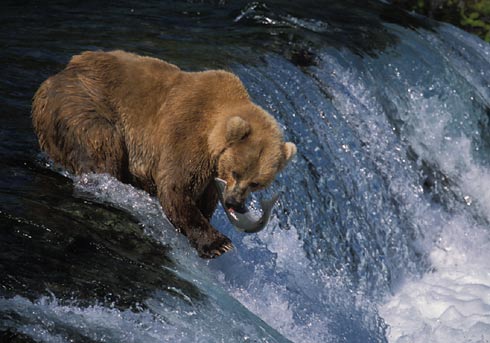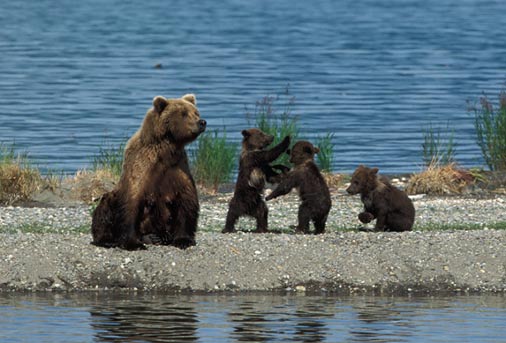|
|

Brown Bears
Katmai National Park, Alaska
 |
| Brown Bears gathered at Brooks Falls feeding on sockeye salmon swimming upstream to their spawning grounds, July 2003. |
 |
| The salmon must propel themselves up and over the fall. One technique for catching them is to wait at the top of the fall and grab them in mid-air. Only the biggest, most dominant bears are able to maintain these choice fishing spots. |
 |
| Once a salmon is caught bears will retreat to a nearby rock or the bank to eat the fish. |
 |
| The skin, brain, and eggs are the most favored parts of the salmon but a hungry bear will eat the entire fish. |
 |
| Another fishing technique is called snorkeling. Bears swim around with their face underwater looking for fish. Healthy salmon can easily swim away from the bear and usually only dead or discarded fish are picked up. |
 |
|
This bear came up empty.
|
 |
| Disagreements sometimes occur but are usually limited to snarling and growling. However, the most dominant bears usually have open wounds and many scars. Once the dominance heirarchy is established posturing is all that is necessary between unequals. |
 |
| Some younger, less experienced bears will chase the salmon in a futile attempt to catch them. |
 |
| This disagreement was not over food. The much larger male is on the right. As you can see below, they later made up. |
 |
|
Young cubs are kept away from other bears for their protection.
|
 |
| Bears stand on their hind legs to get a better view for prey and danger. |
 |
| The injury on the nose of this bear was most likely caused by another Brown Bear. |
 |
|
A female Brown Bear shares her salmon with her first year cub.
|
|
|
|
| All photographs and video on these web pages are the exclusive property of Charles W. Melton and are protected under United States and International copyright laws. The photographs may not be copied, reproduced, manipulated, stored, or distributed without written permission. All rights are reserved.
|
|
|
|
|
|
|
















